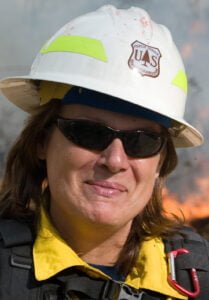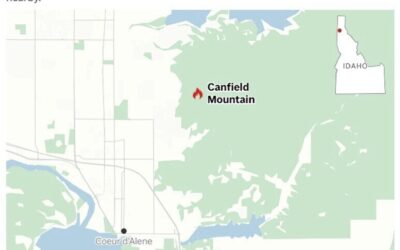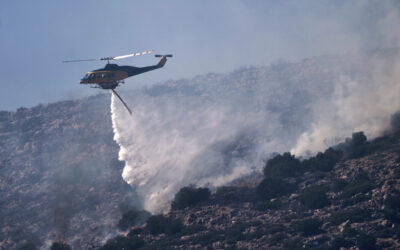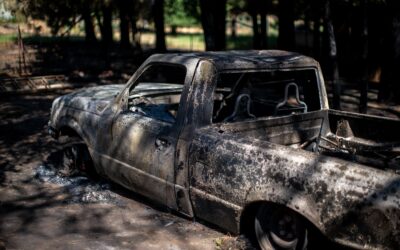How did we get here?
How many government wildland fire response agencies are there in the US today? Well, there are 5 federal agencies with jurisdictional wildland fire suppression and management responsibilities. Most states have responsibilities for wildland fire suppression and management. That’s 55. What about local county and municipal fire departments? Thousands or even 10s of thousands? Today I want to talk about what our wildland firefighting organizations might look like if we designed a response system today and not like what happened 110 years ago.
If you’re reading this, I assume you’re a student of fire. Being a student of fire isn’t just knowing about and understanding fire behavior, fuels, topography and weather. We also acknowledge the importance of leadership skills. And I hope you’ve gotten some good leadership help in my other articles here and on my podcast, BobbieOnFire.com. But there’s more to being a student of fire than “on the ground” fire knowledge and leadership. We also need to understand where we’ve come from. How did we get to where we are today? Many state wildland fire organizations evolved after the US Forest Service and received much of their funding from them as well. So, let’s start with the federal wildland fire agencies and look at their organizations.
There are many good sources where you can learn about the federal wildland fire policies and agencies. I won’t be able to write a complete history here, but let me recommend Stephen J. Pyne’s book, Fire in America. It is a great place to start. In just one book you can learn all about the history of wildland fire suppression in the US. Another excellent book to understand the genesis of national firefighting policy is The Big Burn by Timothy Egan. Taken together, these two books offer insights and knowledge that explains why we do some of the crazy things we do. If you’re anything like me, you’ll soak up the information and wonder about our entire industry.
But let’s start with a quick review. The National Park Service has its roots in the military. Yellowstone National Park was established in 1872 and the military managed it. It wasn’t until 1916 that the NPS was established and assumed responsibility for managing all the parks and monuments. Ever wonder why the “parky” uniform looks so much like the military? There you go. The parks have their roots in their military past.
US Bureau of Land Management? Their history is pretty recent. The BLM wasn’t even established until 1946. Before that they were called the General Land Office and were pretty much responsible for the Homestead Act and getting all the “vacant” federal land settled and developed. The BLM has an interesting history, but it’s a young agency with a very different culture compared to the NPS and the US Forest Service.
For the purposes of this short article, I’m going to concentrate on the US Forest Service and their history because for many years, they were the “big dog” in the yard and drove fire policy. But now that’s evolving.
The US Forest Service was established in 1905. Its mission was to protect the newly created Forest Preserves and National Forests. That duty had been a part of the Department of the Interior before congress established the USFS and pulled them out of Interior and put them into the Department of Agriculture. Why Agriculture? Good question. The answer to that question requires a couple of pitchers of beer sitting around a table and telling stories. Most assuredly there would be some curse words and laughing involved. Yea, history can be crazy.
Back when the USFS was established, there were competing opinions about what to do with the fires that occurred. The prevailing opinion was that the forests should be managed like European forests. More like farms. Thinned and harvested for their valuable crops. And fires are just an anathema to that way of thinking. “Put ‘em out!”
But there were other voices within the USFS and the new American forestry community. Those voices promoted what they called “Indian Burning” or “Light Burning”, modeled after watching indigenous communities manage fire. It’s what we now call prescribed burning.
Those two opposing opinions within the USFS were competing to become policy. Enter the 1910 fires in Montana, Idaho, Washington and British Columbia. It had been unusually hot and dry and then dry lightning moved in and the rest is history. Three million acres burned, and our national fire policy was set for a hundred years. Put ‘em out!
Our history is fascinating. And I really recommend those books to learn more of the details. But now let’s talk about what you or I might change if we were Czar. Our current state and federal fire agencies are what they are because of the history we’ve come from. On the federal side, there has been little change. But many states with active fire management programs have evolved to become much more effective in their suppression efforts. Because state governments are smaller and more nimble, their elected officials have a bit more control over policies and budgets than the huge lumbering federal bureaucracies. Significant organizational changes have taken place in Colorado, Arizona, Washington and California. We’ve seen no significant… or even insignificant organizational changes in the federal wildland agencies. We still organize and operate like we did when I began my career 50 years ago.
Where are we now?
If you work for the USFS, have you ever wondered why the District Ranger oversees and is responsible for the fires on their district? After WW2, most of the District Rangers were military veterans and most often, they were the most qualified firefighter on their district. So, it made sense that they were the “Fire Boss” on their District’s fires. This is the way it was when I began my career.
They are the local administrator for the agency. They are the representative for the Chief of the agency. Yep, the buck stops with them. At most locations, your local FMO/Division Chief works directly for the Ranger. So, the District Ranger must be an expert on fire management, suppression tactics and strategies and be the local expert. I mean, the Captain or Colonel in charge of the troops on the battlefield is presumably the most knowledgeable person on the field. So, it must be the same for the wildland agencies, right? Well then, the Forest Supervisor must have the highest qualifications on the Forest. Uh, no.
Wait! A program that spends more than half of the USFS budget doesn’t have experienced fire professionals responsible for and leading the program at the local level? No. From Washington DC to the local ranger station, the agency administrators have little to no actual firefighting experience. And we wonder why things are the way they are. Don’t misunderstand me. These are sharp, well-meaning people. But the system was designed in a different environment.
Once, while working as an Operations Section Chief on a wildfire, our IMT was managing one large fire and multiple small fires on a National Forest. I explained to the local District Ranger that we needed to concentrate our efforts on the large fire closer to town. The smaller fires in the backcountry were mostly single snags and had little chance to make their way out of the wet high country and against the prevailing winds to make it out of the wilderness and cause a problem. Additionally, we had no resources to put on those small spots. It was too steep, rocky and dangerous to hike anyone into the fires. Not to mention, the local jump base and rappel base were out of firefighters. This was a no brainer. I convinced the District Ranger, but the Forest Supervisor was another matter. As I explained to him, the best fire we can have is one that goes out on it’s own without risking the life of a firefighter. These single tree snags were not worth the risk. Not to mention I had no firefighters to put on it. But he was insistent for me to staff those single tree fires as soon as I could. I never did. Within a few days, the wispy smokes died out and the recon flights and lookouts couldn’t find them anymore.
The Forest Supervisor who told me to staff those snag fires in the wilderness… he was intelligent, experienced and well respected. He just didn’t have any fire experience to understand what his decision meant to us working on the ground. It was a few years later when he was promoted to the Washington Office and was now responsible for a large segment of the USFS fire program. He was now tasked with teaching us Fire Staff Officers (Chief 1s) all about risk management. In other words, how to make good risk informed decisions about large fire strategies. He was a good man and a nice guy… but really? Now he was going to teach us about how to develop appropriate large fire strategies. The irony was almost too much for me to take. He was now in charge of an important segment of the USFS fire program without having a foundational understanding of fire behavior or fire management. He was in that position because he was an agency administrator. Just one example of being led by nice but incompetent leaders.
Our history also led us to have five different federal agencies with wildfire management responsibilities. In addition to the agencies I’ve already mentioned, the Fish and Wildlife Service and the Bureau of Indian Affairs also have fire personnel, policies and organizations separate from the first three.
What’s the saying about a horse designed by committee? You end up with a camel. And that’s what we have. Ever wonder why DOI and FS have different standards and policies? Why do you qualify as a GS-8 engine captain with the USFS but not with the BLM? Why does one agency require educational standards for a position, and another does not?
Ever wonder why it takes such a huge staff of personnel at NIFC? Each agency must have a staff of operational experts, budget analysts, aviation specialists, education professionals and the list goes on and on. We need all those people because we have 5 different federal agencies doing the same thing with different policies, budgets and directions.
Years ago, I was an FMO for the BLM when we negotiated with a nearby National Monument to combine our small fire organizations. When the NPS personnel found out that they were going to have a BLM FMO managing fire on their jurisdiction, they were outraged! “How could a BLM FMO possibly know how to manage fire on a National Monument,” they asked? My reply was, “I have a master’s degree, If you have a fire management plan, I can read and follow it.” I think my sarcasm was lost on them.
That type of parochial thinking is how we’ve stayed in our current mess. That’s the way it is and has been for a very long time.
Where could we be?
In 1900, if Gifford Pinchot and Teddy Roosevelt could have imagined our current national wildland fire morass, do you think they would have designed a system to include 5 federal agencies, 50 state agencies and thousands of local agencies? Not a chance. They were visionaries. And the system they came up with was state of the art for 1910. But this isn’t 1910 and we’re not dealing with 1910 fire challenges.
Many of us have asked the question for years; why do we have so many agencies responsible for fire management in the US? If you travel to Australia or Canada on a fire assignment, you rarely see more than a couple agencies involved on any fire. When was the last time you pulled into fire camp and saw all red trucks or all green trucks or all white trucks. Those days are gone. We operate in an inter-agency manner, which we should. But why do we have so many agencies?
I think we can all agree that maybe our current delivery system isn’t optimal. But what should we have instead? There are a couple of options. The first would be to develop a Federal Wildland Fire Service. This organization would consolidate at least 4 of the 5 federal wildland fire agencies into just one. We would all operate with common policies, standards and personnel. The land management agency could concentrate on their larger mission. Fire management would be accomplished by the Federal Wildland Fire Service. The land management agencies would become the customers for the Federal Fire Service. Suppression strategies would still be determined by the land management agency through their Forest or Resource Management Plan. It would be clear ahead of time and not developed on the quick, late at night when the fire escapes initial attack like we do now.
This new agency would still conduct the prescribed burns and the planning for those burns since they have the expertise, but the burning would be driven by the resource managers. You can imagine there would be a lot to figure out. But wouldn’t you like a seamless response across the landscape regardless of federal jurisdiction? And wouldn’t you also like to be treated equally regardless of where you work and what color your truck is?
Another option to streamline the fire response framework could be to keep the firefighters in each of the 5 federal agencies but place them all in the same organization. In other words, that District FMO/Division Chief and their firefighters are not working for the local District Ranger. Instead, they work for the Forest Fire Chief who in turn works for the Regional Fire Director. The Regional Fire Directors would report to the National Fire Director. In the USFS, there would be a Deputy Chief of the agency, just for fire management.
Would this model really make the necessary changes? Think about the local NPS fire manager who doesn’t work for the Park Superintendent, but works for the Chief Ranger… the lead law enforcement officer for the park. Does that make sense? What does that say about the NPS priority for fire management and our firefighters?
The federal land management agencies are decentralized organizations on purpose. In the old days, it could literally be a two-day mule ride from the ranger station to town where the Forest Headquarters was located. You needed those lone rangers out there to be able to think on their feet and make independent decisions based on their leader’s intent. It’s exactly how we want our fire leadership to make decisions on the fire line. The problem is our decentralized organizations have evolved and drifted into little fiefdoms. No longer do our agencies operate with a singular focus and with the leaders being experts in the field of fire management. We have independent leaders making independent decisions contrary to the well-being of the natural resources and our firefighters. I don’t mean to sound disrespectful to our young agency administrators who depend on their fire professionals for advice and counsel when it comes to fire management decisions. But even those wise local agency administrators can be swayed by internal and external political influences.
As a fire leader have you thought about your professional liability? I had liability insurance when I was still working. But imagine you’ve taken a job as a district ranger or forest supervisor, but you have no fire qualifications. You’re responsible for a very hazardous activity involving millions of dollars and hundreds of lives. How comfortable should you be? It’s like putting me in charge of the nurse’s station at the hospital. I wouldn’t do it.
But make no mistake, this idea is very unpopular within the land management agencies. It’s dramatic, it’s innovative, it upsets the status quo. And that last one is the worse thing you can do in a government bureaucracy.
Do I have all the answers on this issue? Not a chance. Do I have some of the answers. Absolutely yes. Are these ideas new? Not at all. We’ve been talking about them for years. And the topic is complex and nuanced. But don’t let the complexities and the nuances distract from the bigger picture. Our system is broken and needs to be fixed. It’s been broken for years, but it’s “too hard” to fix. The lazy answer is to keep doing the same thing over and over again. There’s no political will in congress to create a new agency to manage our increasing fire problems. And the agencies will push back like a bear protecting her cub against any effort to centralize the fire organizations.
Until there is an honest evaluation of our current organizations and ways to improve our efficiencies, we will keep doing the same thing over and over again while hoping for a different outcome.
Now Available
Both Sides of the Fire Line is Bobbie Scopa’s uplifting memoir of bravely facing the heat of fierce challenges, professionally and personally. It’s available now.
Order from Amazon Order from Barnes & Noble

 Bobbie Scopa started her career as a seasonal firefighter in 1974. After graduating from Arizona State University, she went on to work in fire and natural resource management. Eventually she left the wildand agencies to work full time for a structure fire department. She finished her Masters in Forestry at NC State then went back to the US Forest Service and BLM eventually becoming the Assistant Regional Fire Director in Region 6. Bobbie has spent many years working as a type 1 and 2 Operations Section Chief. You can listen to Bobbie tell audio stories from her long career at BobbieOnFire.com. She has also recently completed her memoir titled “Both Sides Of The Fire Line”. It will be available through Chicago Review Press late summer of 2022.
Bobbie Scopa started her career as a seasonal firefighter in 1974. After graduating from Arizona State University, she went on to work in fire and natural resource management. Eventually she left the wildand agencies to work full time for a structure fire department. She finished her Masters in Forestry at NC State then went back to the US Forest Service and BLM eventually becoming the Assistant Regional Fire Director in Region 6. Bobbie has spent many years working as a type 1 and 2 Operations Section Chief. You can listen to Bobbie tell audio stories from her long career at BobbieOnFire.com. She has also recently completed her memoir titled “Both Sides Of The Fire Line”. It will be available through Chicago Review Press late summer of 2022.


